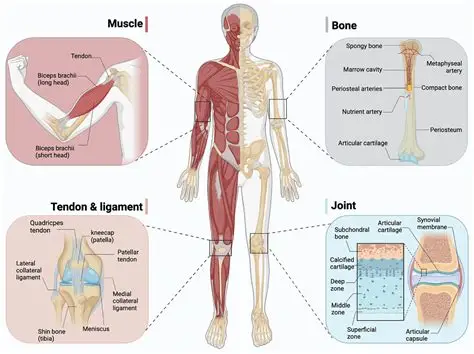Home ›
Qa ›
Musculoskeletal System – Important Questions and Answers (LAQs)
This post provides important long and answer questions based on the muscular system, skeletal system, joints, and related disorders. It is designed for exam preparation and quick revision.
for short answer questions – Musculoskeletal System – Important Short Answer Questions (SAQs)
Detailed note on this Topic 👇👇👇
Muscular & Skeletal System, Joints, and Related Disorders – Complete Study Guide
Questions and Answers
Q1. Compare and contrast the three types of muscles with examples.
Answer:- Skeletal muscles: Striated, voluntary, attached to bones, e.g., biceps and quadriceps.
- Smooth muscles: Unstriated, involuntary, found in internal organs, e.g., stomach wall, intestines.
- Cardiac muscles: Striated, involuntary, branched, found only in the heart.
They differ in structure, control, and function, but all are essential for body movement and survival.
Q2. Explain the sliding filament theory in detail with role of proteins, calcium and ATP.
Answer:The sliding filament theory explains how muscles contract:
- Nerve impulse releases acetylcholine at neuromuscular junction.
- Calcium ions released from sarcoplasmic reticulum bind troponin.
- Actin sites exposed, myosin heads attach forming cross-bridges.
- ATP hydrolysis provides energy, pulling actin filaments inward.
- Sarcomere shortens, causing contraction.
- When impulse ends, calcium reabsorbed, muscles relax.
Q3. Discuss the impact of aging on bones, cartilage and muscles with prevention methods.
Answer:Aging reduces bone density (osteoporosis), makes cartilage brittle (osteoarthritis), and causes muscle mass loss (sarcopenia).
Prevention methods include regular exercise, strength training, balanced diet with calcium and vitamin D, and avoiding sedentary lifestyle.
Q4. Describe seven common sports injuries with causes, symptoms and treatment.
Answer:1. Muscle strain: Overstretching → pain, swelling.
2. Shin splints: Stress on tibia → shin pain.
3. Shoulder injury: Overuse → rotator cuff pain.
4. Lower back pain: Poor posture/exercise form.
5. Tennis elbow: Repeated forearm use → tendon pain.
6. Ankle sprain: Twisting → ligament tear.
7. Groin strain: Excess running/jumping → inner thigh pain.
Treatment: RICE (Rest, Ice, Compression, Elevation), physiotherapy, proper warm-up, correct footwear.
Q5. Explain the role of balanced diet in maintaining muscle health and dangers of processed food.
Answer:A balanced diet with lean protein, complex carbs, vitamins and minerals supports muscle growth, repair and endurance.
Processed foods with high sugar, fat and sodium reduce recovery, increase inflammation, and weaken muscle performance. Long-term, they contribute to obesity, insulin resistance and poor musculoskeletal health.






